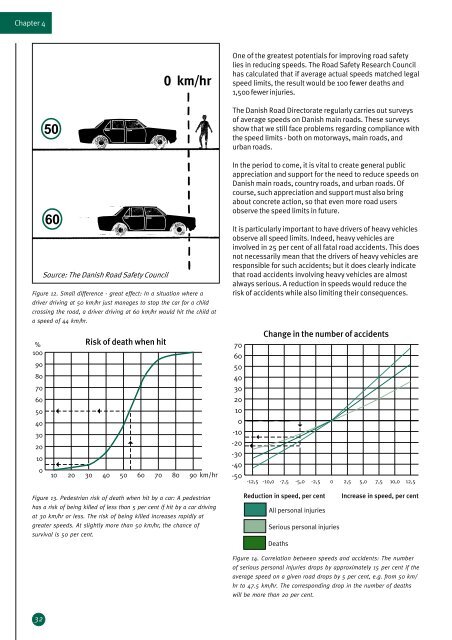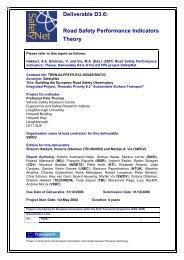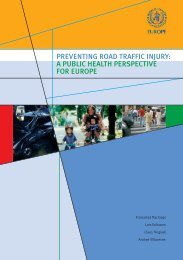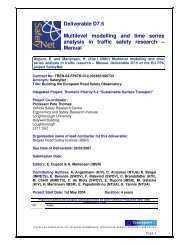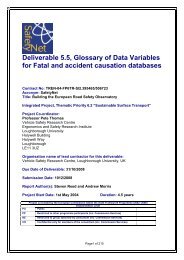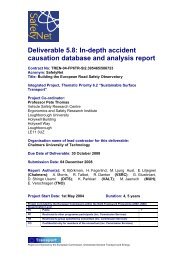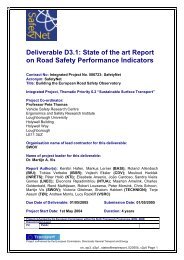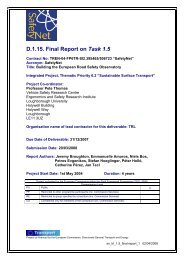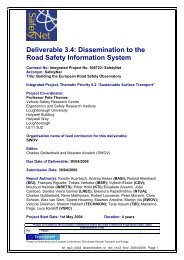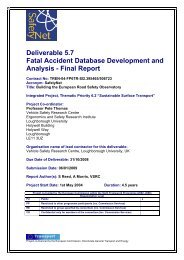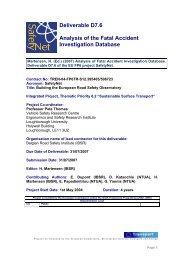Every Accident is One Too Many Every Accident is One ... - UNECE
Every Accident is One Too Many Every Accident is One ... - UNECE
Every Accident is One Too Many Every Accident is One ... - UNECE
Create successful ePaper yourself
Turn your PDF publications into a flip-book with our unique Google optimized e-Paper software.
Chapter 4<br />
0<br />
km/hr<br />
<strong>One</strong> of the greatest potentials for improving road safety<br />
lies in reducing speeds. The Road Safety Research Council<br />
has calculated that if average actual speeds matched legal<br />
speed limits, the result would be 100 fewer deaths and<br />
1,500 fewer injuries.<br />
%<br />
100<br />
50<br />
60<br />
Source: The Dan<strong>is</strong>h Road Safety Council<br />
Figure 12. Small difference - great effect: In a situation where a<br />
driver driving at 50 km/hr just manages to stop the car for a child<br />
crossing the road, a driver driving at 60 km/hr would hit the child at<br />
a speed of 44 km/hr.<br />
R<strong>is</strong>k of death when hit<br />
90<br />
80<br />
70<br />
60<br />
50<br />
40<br />
30<br />
20<br />
10<br />
0<br />
10 20 30 40 50 60 70 80 90 km/hr<br />
Figure 13. Pedestrian r<strong>is</strong>k of death when hit by a car: A pedestrian<br />
has a r<strong>is</strong>k of being killed of less than 5 per cent if hit by a car driving<br />
at 30 km/hr or less. The r<strong>is</strong>k of being killed increases rapidly at<br />
greater speeds. At slightly more than 50 km/hr, the chance of<br />
survival <strong>is</strong> 50 per cent.<br />
The Dan<strong>is</strong>h Road Directorate regularly carries out surveys<br />
of average speeds on Dan<strong>is</strong>h main roads. These surveys<br />
show that we still face problems regarding compliance with<br />
the speed limits - both on motorways, main roads, and<br />
urban roads.<br />
In the period to come, it <strong>is</strong> vital to create general public<br />
appreciation and support for the need to reduce speeds on<br />
Dan<strong>is</strong>h main roads, country roads, and urban roads. Of<br />
course, such appreciation and support must also bring<br />
about concrete action, so that even more road users<br />
observe the speed limits in future.<br />
It <strong>is</strong> particularly important to have drivers of heavy vehicles<br />
observe all speed limits. Indeed, heavy vehicles are<br />
involved in 25 per cent of all fatal road accidents. Th<strong>is</strong> does<br />
not necessarily mean that the drivers of heavy vehicles are<br />
responsible for such accidents; but it does clearly indicate<br />
that road accidents involving heavy vehicles are almost<br />
always serious. A reduction in speeds would reduce the<br />
r<strong>is</strong>k of accidents while also limiting their consequences.<br />
70<br />
60<br />
50<br />
40<br />
30<br />
20<br />
10<br />
0<br />
-10<br />
-20<br />
-30<br />
-40<br />
-50<br />
-12,5<br />
Change in the number of accidents<br />
-10,0<br />
-7,5<br />
All personal injuries<br />
Serious personal injuries<br />
Deaths<br />
-5,0<br />
-2,5<br />
Reduction in speed, per cent<br />
0<br />
2,5<br />
5,0<br />
7,5<br />
10,0<br />
12,5<br />
Increase in speed, per cent<br />
Figure 14. Correlation between speeds and accidents: The number<br />
of serious personal injuries drops by approximately 15 per cent if the<br />
average speed on a given road drops by 5 per cent, e.g. from 50 km/<br />
hr to 47.5 km/hr. The corresponding drop in the number of deaths<br />
will be more than 20 per cent.<br />
32


